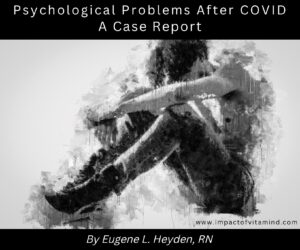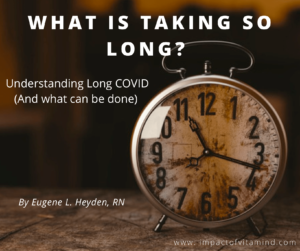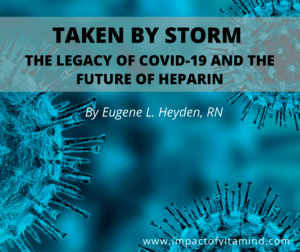COVID-19? I like what I’m hearing about famotidine

Last update: 08-19-23
By Eugene L. Heyden, RN
“Famotidine use was associated with a reduced risk of death and intubation. By comparison proton pump inhibitors (that reduce gastric acid independent of a histamine mechanism) were not associated with reduced risk of death or intubation.” ~Hogan II et al., 2020
I like the sound of this! Reduced risk of death from COVID-19, reduced need for intubation—all from a medication that is commonly available and has safety written all over it. The medication is called famotidine, or more commonly, PEPCID®. Have we got a new therapeutic on our hands?
Sources tell me that the story of famotidine vs. COVID-19 began with an individual who is both a physician and a scientist (Malone, 2021). The individual in question just happened to be leading a research team who were attempting to identify drugs that could be repurposed to treat COVID-19. Famotidine was one of the top drugs identified as holding promise. And then the unthinkable occurred. While involved in this research project, our physician/scientist friend contracted COVID-19. It was not mild and was certainly concerning. “Shortness of breath and lung burning” is, apparently, nature’s way of telling physicians and scientists that it’s time to do something to prevent disease progression, avoid intubation, and avoid death.
Wanting no part of what COVID-19 has to offer, our physician/scientist friend began a regimen of famotidine, 60 mg three times a day. Almost immediately, symptoms improved—so much so that after seven days of treatment, therapy was discontinued. However, stopping famotidine was a bit premature, as symptoms would return. This turn of events prompted a resumption of famotidine, same dosage and timing, for another 7 days. Apparently, that was all that was needed, and recovery was achieved.
As if in concert, other individuals, symptomatic and testing positive for COVID-19 (with one exception), experienced this same sort of thing—relief from symptoms of COVID-19 by taking the drug famotidine. The stories of 10 such individuals are told in by Janowitz and associates. We’ll take a look at several case reports as we continue.
Case 1 is an individual in her 40s, with a history of epilepsy, and apparently in good general health. Four days after the onset of COVID symptoms, she began taking famotidine, 80mg three times per day, and did so for a period of 11 days. So, how did it go? “Within 1 day of the first dose of famotidine, she noticed marked improvement of her shortness of breath. This improvement was matched by an increase in her home-monitored pulse oximetry measured oxygen saturation levels from 91%–95% to 97%–98%. She was febrile with a temperature of 37.8°C [100°F] prior to starting famotidine and afebrile on day 7 of taking famotidine.” (Janowitz et al., 2020) Nice! No intubation. No death. No grieving family.
Case 2 is a young man in his 30s, without pre-existing conditions. COVID symptoms, including “severe shortness of breath,” were tolerated for 9 days, then enough is enough. Famotidine was started at a dose of 80 mg then taken three times a day. By treatment day 7, he had definitely improved. “His home monitored oxygen saturation levels improved from 89% on day 2 of treatment to 96% on day 5 of treatment. He was febrile with a temperature of 38.9°C prior to starting famotidine and afebrile on day 5 of taking famotidine. He intermittently took paracetamol [acetaminophen] for fever during illness.” (Janowitz et al., 2020)
Case 3 is a young lady in her 20s with no pre-existing conditions to report. Nine days after experiencing COVID symptoms she began famotidine, 80 mg three times a day. And the result? “She felt markedly better within 2 days of treatment but had mild dizziness and accelerated heart beats intermittently while taking famotidine.” (Janowitz et al., 2020)
Case 4 is a lady in her 20s, considerably overweight but otherwise healthy. COVID symptoms were the usual—fatigue, headache, shortness of breath. Six days after symptom onset, she began taking famotidine 80mg three times daily. “Within 1 week of treatment, she reported relief of most symptoms. She reported grade 1 dizziness, insomnia and dry skin concurrent with taking famotidine.” Famotidine was discontinued after day 12 of therapy. (Janowitz et al., 2020)
Case 5 is a gentleman in his 70s who had been experiencing the symptoms of COVID-19 for over three weeks, including fatigue, shortness of breath, coughing, and feeling like crap (medical term). His medical history included a heart attack, chronic pancreatitis, and chronic back pain. Continuing, “His diagnosis is based on clinical symptoms and signs and being from a high prevalence location, with all family members being clinically affected by COVID-19. He took Famotidine 60 mg two times daily for 5 days starting 26 days after first experiencing symptoms of COVID-19. He reported a rapid improvement and being asymptomatic within 3 days of treatment.” (Janowitz et al., 2020)
These cases are all starting to sound the same—someone sick from COVID, famotidine to the rescue, nice response. I could relay more stories of success from Janowitz et al, but let’s wrap things up with a report from another team of investigators. This case is quite lengthy and complex, but I will try to keep things brief and simple.
Case 6 is a 47-year-old gentleman who tested positive for COVID-19 some 8 days after experiencing “diarrhea, abdominal cramping, eructation, low energy, dry cough, arthralgia, myalgia, anosmia and ageusia [loss of smell and taste].” (Malone et al., 2021) The patient had the comorbidities working against him—hypertension, diabetes, gout, elevated cholesterol—for which medication was required to control. Also on day 8, began a fever (102°F), night sweats, shortness of breath, and chest pressure—things that make one wonder what’s up next. Time to get down to business! PEPCID AC ®, 60 mg three per day, was initiated. And it didn’t take long before results could be seen.
“After initiating famotidine in the evening, the patient was able to sleep through the night and reported complete relief from the chest pressure sensation, reduction in cough sensation, but continued to be febrile (101.6°F).” (Malone et al., 2021) So far, so good. But on day 10, things did not look so good.
“On day 10, he presented to the emergency room (ER) with continuing complaints of diarrhea, abdominal cramping, eructation, low energy, dry cough, arthralgia, myalgia, anosmia and ageusia and shortness of breath on exertion.” Fortunately, following a thorough workup, it was determined that our gentleman was suffering from dehydration. After I.V. fluids and a little something for nausea, he was discharged for home. And home he went to continue his recovery from COVID-19, only to return to the ER in 5 days.
This second visit to the ER was for evaluation for a near-fainting episode, occurring while taking a shower. His physical examination “unremarkable,” sats were good, and a chest X-ray was no worse and perhaps a little better. For good measure, and antibiotic was ordered, and our gentleman was on his way.
It all turned out well for the gentleman of our story—and the argument could be made that famotidine saved the day. “On days 27 and 28 after initial symptoms, he tested negative (2x, successive days) for SARS-CoV-2 nucleic acid by PCR (intranasal swab) and returned to his work at the local hospital 31 days after initial symptoms. 47 days after first developing COVID-19 symptoms he continues to note a lack of ability to taste or smell, but otherwise considers himself largely recovered from COVID-19.”
Conclusion
“It is noteworthy that H2R, the established molecular target of famotidine, is involved in the activation of several mediators of the adaptive immune response, such as T1 lymphocytes, which are implicated in pro-inflammatory cytokine production. Histamine, the H2R ligand, also regulates bronchoconstriction, airway inflammation, and vasodilation. Mast cells are a major source of histamine and their activation has been reported following viral infections of the respiratory tract.” ~Lofredo et al., 2021
Why the success of famotidine in the above case reports? Let’s see . . .
- Famotidine blocks histamine release, a molecule involved in inciting “cytokine storm” in COVID-19 (Hogan II et al., 2020)
- Famotidine reduces inflammation and cytokine release, both of which are involved in COVID-19 disease severity (Hogan II et al., 2020)
- Famotidine “inhibits histamine-induced expression of Toll-like receptor 3 (TLR3) in SARS-CoV-2 infected cells . . . subsequently controlling antiviral and inflammatory responses.” (Lofredo et al., 2021)
- Famotidine can limit bronchoconstriction, thereby improving gas exchange (Lofredo et al., 2021).
Finally, and as always, treatment for a disease should always be under the direction of a qualified healthcare professional, and that would include the use of famotidine for the treatment of COVID-19. To underscore this assertion (this commandment), “it should be noted that while famotidine is one of the relatively safer drugs, its use is not without risk, especially in elderly patients (a high-risk population for COVID-19), in which famotidine use has been associated with CNS complications.” (Lofredo et al., 2021)
Related posts (Click on image to open)
References
Freedberg DE, Conigliaro J, Wang TC, Tracey KJ, Callahan MV, Abrams JA, Sobieszczyk ME, Markowitz DD, Gupta A, O’Donnell MR, Li J. Famotidine use is associated with improved clinical outcomes in hospitalized COVID-19 patients: a propensity score matched retrospective cohort study. Gastroenterology. 2020 Sep 1;159(3):1129-31. https://www.gastrojournal.org/article/S0016-5085(20)34706-5/abstract
Hogan II RB, Hogan III RB, Cannon T, Rappai M, Studdard J, Paul D, Dooley TP. Dual-histamine receptor blockade with cetirizine-famotidine reduces pulmonary symptoms in COVID-19 patients. Pulmonary pharmacology & therapeutics. 2020 Aug 1;63:101942. https://www.sciencedirect.com/science/article/pii/S1094553920301462
Janowitz T, Gablenz E, Pattinson D, Wang TC, Conigliaro J, Tracey K, Tuveson D. Famotidine use and quantitative symptom tracking for COVID-19 in non-hospitalised patients: a case series. Gut. 2020 Sep 1;69(9):1592-7. https://gut.bmj.com/content/69/9/1592.abstract
Loffredo M, Lucero H, Chen DY, O’Connell A, Bergqvist S, Munawar A, Bandara A, De Graef S, Weeks SD, Douam F, Saeed M. The in-vitro effect of famotidine on SARS-CoV-2 proteases and virus replication. Scientific reports. 2021 Mar 8;11(1):1-9. https://www.nature.com/articles/s41598-021-84782-w
Malone RW. More than just heartburn: does famotidine effectively treat patients with COVID-19?. Digestive Diseases and Sciences. 2021 Nov;66(11):3672-3. https://link.springer.com/article/10.1007/s10620-021-06875-w
Malone RW, Tisdall P, Fremont-Smith P, Liu Y, Huang XP, White KM, Miorin L, Moreno E, Alon A, Delaforge E, Hennecker CD. COVID-19: famotidine, histamine, mast cells, and mechanisms. Frontiers in Pharmacology. 2021 Mar 23;12:633680. https://www.frontiersin.org/articles/10.3389/fphar.2021.633680/full
Mukherjee R, Bhattacharya A, Bojkova D, Mehdipour AR, Shin D, Khan KS, Cheung HH, Wong KB, Ng WL, Cinatl J, Geurink PP. Famotidine inhibits toll-like receptor 3-mediated inflammatory signaling in SARS-CoV-2 infection. Journal of Biological Chemistry. 2021 Aug 1;297(2). https://www.jbc.org/article/S0021-9258(21)00725-0/abstract
DISCLAIMER: This article is offered solely for informational purposes. The information contained therein and opinions expressed should be evaluated for accuracy and validity in the context of opposing data, new information, and the views and recommendations of a qualified health care professional, and not to be substituted for professional judgment and guidance or to provide a reason to neglect or delay appropriate medical care for self or for others. It is the reader and reader only who bears the responsibility for any actions that could be construed as being a response to the information presented. The statements and opinions expressed by the author have not been reviewed or approved by the FDA or by any other authoritative body, nor is the author endorsing any product or specific therapy mentioned. This article and the opinions contained therein are offered to the reader to broaden his or her understanding of the issues discussed and to help identify options that may be suitable for the individual to pursue, on behalf of self or others, under approval and direction of a qualified physician or medical team member. All questions of a medical nature which arise from reading this article should be directed at qualified health care professional. There are no guarantees that a suggested website and internal links are safe to visit or open or are currently available.
Copyright © 2022 Eugene L. Heyden, RN
All Rights Reserved.



